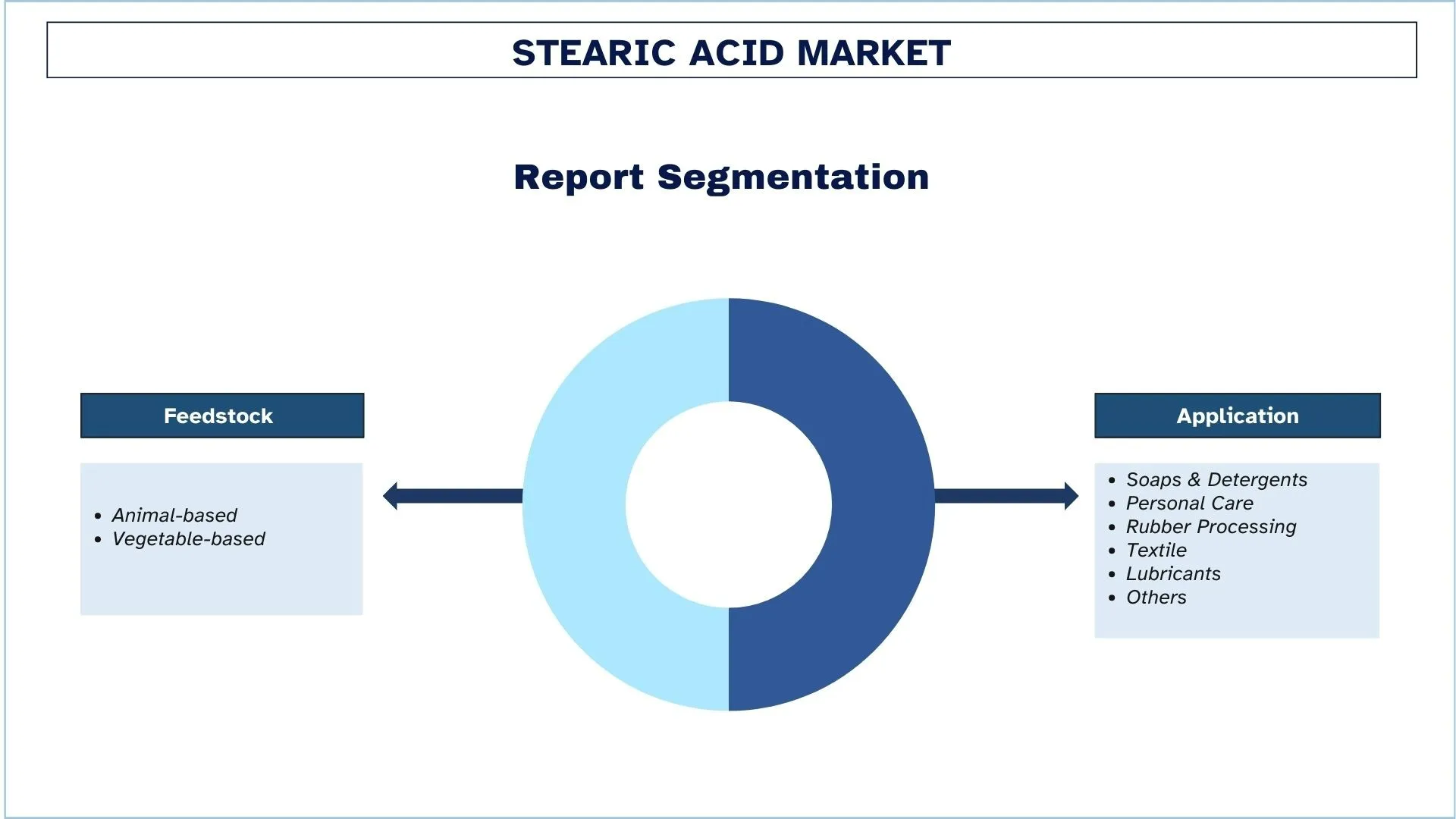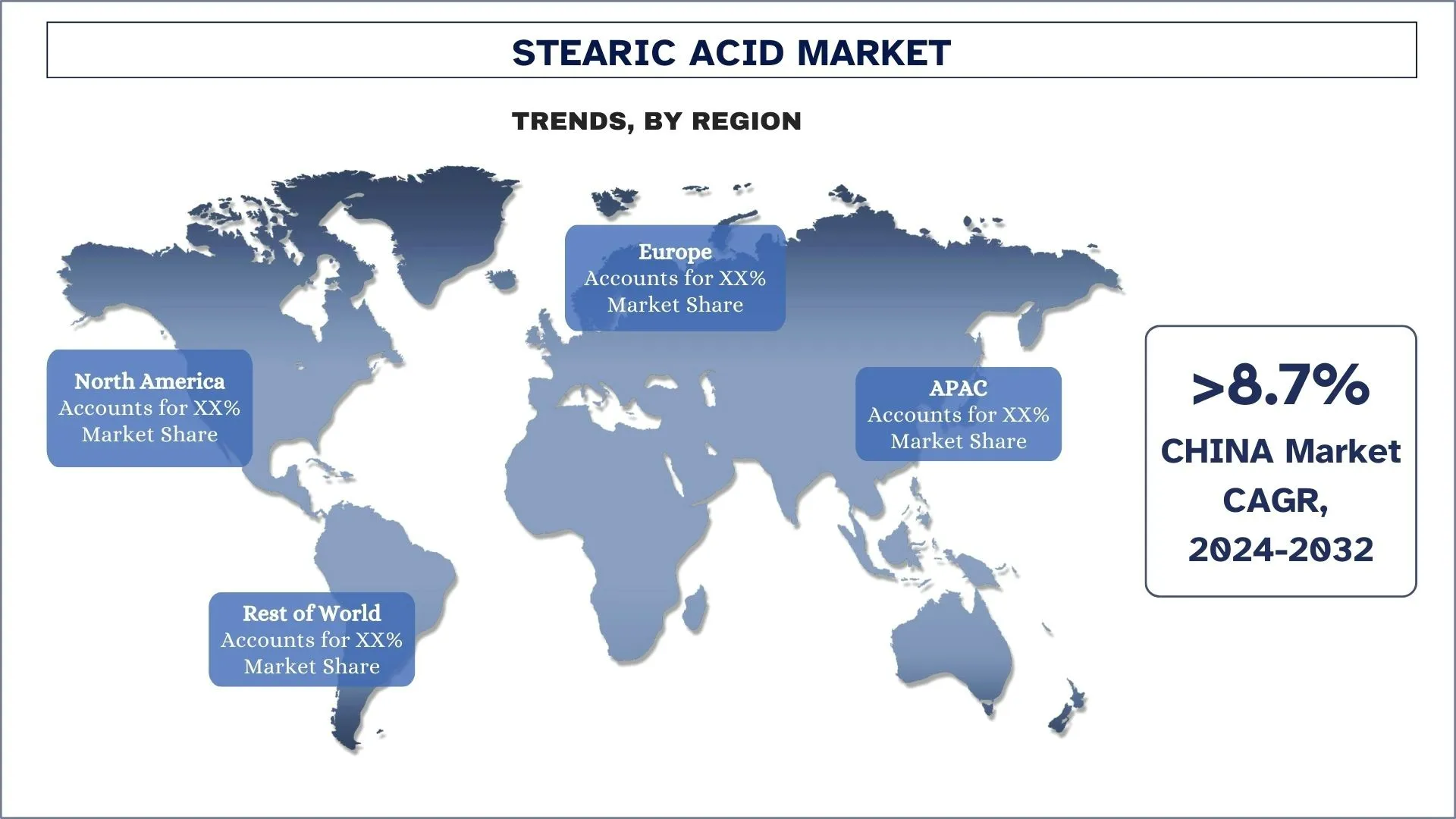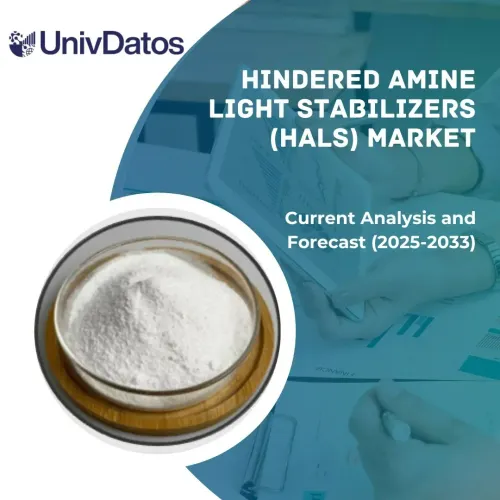
ステアリン酸市場規模と予測
ステアリン酸市場は2023年に321億6410万米ドルと評価され、化粧品およびパーソナルケア産業からの需要増加、および持続可能な植物由来代替品への移行により、予測期間(2024~2032年)中に約7.1%の力強いCAGRで成長すると予想されます。
ステアリン酸市場分析
ステアリン酸は、化粧品、パーソナルケア、医薬品、食品、および工業用途で広く使用されている化学産業の主要なサブフィールドです。飽和脂肪酸からのステアリン酸は、動物性脂肪と植物油の両方から入手可能ですが、環境上の理由から業界は植物油を好みます。パーソナルケア企業は、製品製造において製品のテクスチャを制御し、混合物を準備するためにステアリン酸を必要としているため、より多くのステアリン酸を必要としています。複数のプロセスで製造物質として機能することにより、その実用的な用途が拡大しています。人々は現在、製品をより環境に優しくするために植物由来のステアリン酸を選択しており、これらの顧客の嗜好がすべての産業で市場の拡大を後押ししています。
中国、インド、東南アジアなどの国々が急速に工業化し、消費財と製造業が製品の使用を拡大するため、ステアリン酸市場は発展途上地域で急速に成長します。これらの地域では消費者支出が急速に増加しており、パーソナルケア、自動車、および繊維セクターの発展を促進しており、これらはステアリン酸製品を使用しています。インドは、その化粧品製造が拡大し、消費者が持続可能な製品を受け入れているため、ステアリン酸の主要なターゲット市場としての地位を確立しています。世界的な製造センターとして、中国は産業発展サイクルを通じてステアリン酸の需要を増加させ続けています。これらの地域は、地元の生産活動から恩恵を受けており、国際企業は急速に拡大する経済での市場シェアを獲得するために投資を行っています。
ステアリン酸市場動向
このセクションでは、当社の研究専門家チームが特定した、ステアリン酸市場のさまざまなセグメントに影響を与える主要な市場動向について説明します。

化粧品およびパーソナルケア産業からの需要の増加
化粧品部門は、配合物を安定させ、油性と水性の成分間の良好なブレンドを維持するためにステアリン酸に依存しています。この物質は、典型的なスキンケア製品の製造において油と水をシームレスに統合します。スキンケア分野はより良い製品を必要としているため、ユーザーは化粧品開発に不可欠な成分としてステアリン酸を必要としています。顧客が環境に優しい成分に基づいて選択を行うため、市場は植物由来のステアリン酸の使用から恩恵を受けています。
工業用途の拡大
パーソナルケア製品の開発以外にも、ステアリン酸はいくつかの工業用途を通じてその価値を強化します。ステアリン酸は、メーカーが生産設備をよりスムーズに操作し、その寿命を延ばす潤滑剤として役立ちます。ステアリン酸は、メーカーが柔軟で安定したプラスチック製品を製造するのに役立ちます。企業は、ゴムが製造プロセス中に最適に機能するように、ゴムの動作を改善するためにステアリン酸を使用しています。世界中の自動車および繊維生産の増加と建設プロジェクトの増加により、工業用ステアリン酸の消費が促進されています。
植物由来および持続可能な成分への嗜好の増加
環境問題のため、人々や企業はパーム油やココナッツ油の生産から得られる植物由来の成分をステアリン酸に使用することを好んでいます。消費者は環境に優しい選択肢を求めているため、動物由来のものよりも植物由来のステアリン酸を好みます。メーカーは、連邦法がそれらを義務付けていること、およびバイヤーが製造エネルギー出力を削減したいと考えているにもかかわらず、環境に優しいアイテムを求めているため、材料を変更しています。人々は、化粧品およびパーソナルケア製品市場の両方で、植物由来のステアリン酸を増加傾向で購入し続けています。
石鹸および洗剤市場の成長
ステアリン酸は、製品の厚みを構築し、混合物がブレンドされた状態を維持し、泡の生成を促進するため、石鹸および洗剤の重要な成分として機能します。ステアリン酸は、汚れや油性の物質を除去することにより、製品の使用感を向上させ、より効果的に機能させます。世界中でより高い衛生基準と環境に優しい高級クリーニング製品に対する消費者の嗜好により、石鹸および洗剤部門が発展しました。高品質で倫理的な商品を重視する顧客は、主に富裕層の国々でこの需要が高まっているため、ステアリン酸のより良い市場機会を創出します。
ステアリン酸業界セグメンテーション
このセクションでは、2024年から2032年までの世界、地域、および国レベルでの予測とともに、ステアリン酸の世界市場レポートの各セグメントにおける主要なトレンドの分析を提供します。
植物由来の原料市場がステアリン酸市場を支配
原料に基づいて、市場は動物由来と植物由来に分類されます。これらのうち、植物由来の原料市場は、著しいCAGRで成長しています。顧客は、美容、セルフケア、食品生産市場で環境に優しい製品をサポートしているため、植物由来のステアリン酸を選択しています。人々が地球の防衛に専念すると、彼らは動物製品の代わりに植物材料を使用することを選択します。顧客の選択パターンの変化は、環境および品質基準に従って、企業がバイオベース製品を製造および規制することを奨励しています。環境に重点を置く企業は、その持続可能性の利点と倫理的な調達を愛しているため、市場は植物から派生した植物性ステアリン酸を歓迎しています。
石鹸・洗剤セグメントがステアリン酸市場を支配
用途に基づいて、ステアリン酸市場は石鹸・洗剤、パーソナルケア、ゴム加工、繊維、潤滑剤、およびその他に分けられます。石鹸・洗剤セグメントは、予測期間中に著しいCAGRを記録しました。石鹸と洗剤がステアリン酸を必要とする主な理由は、それが界面活性剤として効果的に機能し、製品成分を乳化および増粘させるためです。石鹸と洗剤は、高品質の革と厚みを必要とするため、流動性を制御し、より大きな発泡作用を可能にするため、ステアリン酸を必要とします。この化学物質は、汚れやグリースをより簡単に除去することにより、洗剤の洗浄作用を支援します。ステアリン酸は、石鹸や洗剤での使用中に効果的で持続可能な処方に対する顧客のニーズを満たすため、洗浄製品の開発において重要な役割を果たしています。
APACは予測期間中に著しいCAGRで成長すると予想されます
アジア太平洋地域は、その産業拡大と消費者発展が人口の中間層のバイヤーが急速に拡大しているため、高い速度で進行しているため、世界市場の成長をリードしています。中国、インド、東南アジアの自動車および化学工場は、操業を拡大しており、産業活動におけるステアリン酸の要件が高まっています。世界中のより多くの人々が環境に優しいパーソナルケア製品を選択しており、天然資源から得られるステアリン酸に対する持続的な需要を生み出しています。ここのパーソナルケアおよび化粧品ビジネスの成長は、消費者がより良い天然製品の選択肢を求めているため、市場のパフォーマンスを向上させます。
各国のステアリン酸製品の製造には、従来の供給源の代わりに、ココナッツ油とパーム油が選択されています。インドと中国の中間層の家族の収入が増加し、高級パーソナルケア製品や高品質の家庭用品にお金を費やす顧客が増えています。メーカーによる高級品の生産と高価なグリーンテクノロジー向けの成長ビジネスにより、APACは世界最大のステアリン酸市場となっています。市場の拡大は、環境に優しい製品に対する政府の支援に依存しており、これによりAPACはこれらのアイテムをより多く生産し、使用しています。

ステアリン酸業界の競争環境
ステアリン酸市場は競争が激しく、断片化されており、いくつかのグローバルおよび国際的な市場プレーヤーが存在します。主要なプレーヤーは、パートナーシップ、合意、コラボレーション、新製品の発売、地理的拡大、合併および買収などのさまざまな成長戦略を採用して、市場での存在感を高めています。
主要なステアリン酸製造企業
市場で事業を展開している主要なプレーヤーには、BASF SE、3F Industries Ltd.、新日本理化株式会社、Oleon NV、Wilmar International、Emery Oleochemicals、Cayman Chemical、Twin Rivers Technologies、Kao Chemicals、KLK Oleoなどがあります。
ステアリン酸市場における最近の動向
2020年1月、BASF SEは、2020年にSolvayのポリアミド部門を買収し、ステアリン酸事業を取得した後、持続可能な化学ビジネスを拡大しました。この事業転換は、現在多くの企業が顧客に持続可能で再生可能な製品オプションを提供したいと考えていることを示しています。
ステアリン酸市場レポートの対象範囲
レポート属性e | 詳細 |
基準年 | 2023 |
予測期間 | 2024~2032年 |
成長の勢い | 7.1%のCAGRで加速 |
市場規模2023年 | 321億6410万米ドル |
地域分析 | 北米、ヨーロッパ、APAC、世界のその他 |
主要貢献地域 | アジア太平洋地域は、予測期間中に最高のCAGRで成長すると予想されています |
対象国 | 米国、カナダ、ドイツ、スペイン、イタリア、フランス、英国、中国、日本、韓国、インド |
プロファイルされた企業 | BASF SE、3FインダストリーズLtd.、新日本理化株式会社、Oleon NV、Wilmar International、Emery Oleochemicals、Cayman Chemical、Twin Rivers Technologies、花王ケミカル、およびKLK Oleo。 |
レポートのスコープ | 市場動向、推進要因、抑制要因; 収益の推定と予測; セグメンテーション分析; 需要と供給側の分析; 競争環境; 企業プロファイリング |
対象セグメント | 原料別; 用途別; 地域/国別 |
ステアリン酸市場レポートを購入する理由:
この調査には、認証された主要な業界専門家によって検証された市場規模と予測分析が含まれています。
このレポートは、全体的な業界のパフォーマンスを一目で確認できる概要を提供します。
このレポートは、主要な事業財務、製品ポートフォリオ、拡張戦略、および最近の動向に焦点を当て、著名な業界関係者の詳細な分析をカバーしています。
業界で蔓延している推進要因、抑制要因、主要なトレンド、および機会の詳細な検討。
この調査は、さまざまなセグメントにわたる市場を包括的にカバーしています。
業界の詳細な地域レベル分析。
カスタマイズオプション:
グローバルステアリン酸市場は、要件やその他の市場セグメントに合わせてさらにカスタマイズできます。これに加えて、UnivDatosは、お客様独自のビジネスニーズがある可能性があることを理解しており、お客様の要件に完全に合致するレポートを入手するために、お気軽にお問い合わせください。
目次
ステアリン酸市場分析(2024-2032)の研究方法論
世界中の主要地域での用途を評価するために、過去の市場を分析し、現在の市場を推定し、グローバルステアリン酸市場の将来の市場を予測しました。過去の市場データを収集し、現在の市場規模を推定するために、徹底的な二次調査を実施しました。これらの洞察を検証するために、数多くの調査結果と仮定を注意深くレビューしました。さらに、ステアリン酸バリューチェーン全体の業界専門家との詳細な一次インタビューを実施しました。これらのインタビューを通じて市場 figuresを検証した後、トップダウンとボトムアップの両方のアプローチを使用して、全体の市場規模を予測しました。その後、市場内訳とデータ三角測量法を使用して、業界セグメントとサブセグメントの市場規模を推定および分析しました。
市場エンジニアリング
データ三角測量法を使用して、全体的な市場推定を最終決定し、グローバルステアリン酸市場の各セグメントおよびサブセグメントの正確な統計数値を導き出しました。原料、用途、およびグローバルステアリン酸市場内の地域など、さまざまなパラメーターとトレンドを分析することにより、データをいくつかのセグメントとサブセグメントに分割しました。
グローバルステアリン酸市場調査の主な目的
この調査では、グローバルステアリン酸市場の現在および将来のトレンドを特定し、投資家向けの戦略的洞察を提供します。地域市場の魅力を強調し、業界関係者が未開拓市場に参入し、先発者利益を得られるようにします。調査のその他の定量的目標には、以下が含まれます。
市場規模分析:グローバルステアリン酸市場とそのセグメントの現在の市場規模と予測市場規模を、金額(USD)で評価します。
ステアリン酸市場セグメンテーション:調査のセグメントには、原料、用途、および地域の分野が含まれます。
規制フレームワークとバリューチェーン分析:ステアリン酸業界の規制フレームワーク、バリューチェーン、顧客行動、および競争環境を調査します。
地域分析:アジア太平洋、ヨーロッパ、北米、および世界のその他の主要地域について詳細な地域分析を実施します。
企業プロファイルと成長戦略:急速に成長している市場で持続するための、ステアリン酸市場の企業プロファイルと市場プレーヤーが採用する成長戦略。
よくある質問 よくある質問
Q1: ステアリン酸市場の現在の市場規模と成長の可能性は?
ステアリン酸市場は2023年に321億6410万米ドルと評価され、予測期間(2024-2032年)中に約7.1%の力強いCAGRで成長すると予想されます。
Q2: ステアリン酸市場の成長を促進する要因は何ですか?
ステアリン酸市場の成長は、パーソナルケア、化粧品、製薬業界からの需要の増加、プラスチック、ゴム加工、工業用途での利用の増加によって牽引されています。
Q3: 原料別にステアリン酸市場で最大のシェアを持つセグメントは?
植物ベースの原料市場は、原料別のステアリン酸市場で最大のシェアを占めています。
Q4: ステアリン酸市場における新興技術とトレンドは何ですか?
ステアリン酸市場における新興技術とトレンドには、バイオベースで持続可能な製造方法、精製技術の進歩、生分解性プラスチックとグリーンケミカルへの応用拡大が含まれます。
Q5: どの地域がステアリン酸市場で優勢になりますか?
APACは、予測期間中に市場を支配すると予想されています。
関連 レポート
この商品を購入したお客様はこれも購入しました










